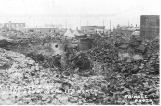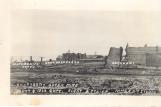1
The Haileybury Fire by S.J. MasonFebruary 1, 1984
On 4 October 1922 one of the "ten worst disasters" in Canadian History occurred. It was to be known as the Haileybury Fire, since Haileybury was the largest community to suffer in the blaze. The Fire covered approximately 300,000 acres, extending from north of Charlton to south of North Cobalt and from the Quebec border to the Montreal River on the west. The Villages of Charlton, Heaslip, and Thornloe and nine-tenths of Haileybury were completely destroyed; 43 people lost their lives, including 11 in the Town of Haileybury.
Government regulations permitted settlers to burn brush to improve their farms after September 15 without a permit. The fall had been hot and dry, fanned by strong westerly winds these many small fires became one gigantic fire-front, approaching the T.&N.O. Railways right-of-way on October 4th. Fortunately for Englehart and New Liskeard the wind was to change to the north and those two communities were to suffer only slight loss.
Haileyburians had gazed at a sun obscured by heavy smoke for several days, but with little thought of disaster. At noon on October the 4th a clanging fire-bell summoned all able-bodied men to the railway in the vicinity of the station. Using fire hose, picks and shovels, they made a desperate effort to contain the fire, which had bypassed the houses on the West Road. These were to burn later from another bush fire. Had the wind not been so strong they might have been successful in their efforts but other factors contributed to what became an impossible task.
At 4:00 pm, disaster! A north-bound train severed the hose lines and simultaneously hydro was cut off, which shut down the water pumps. At that moment, it was noticed that the roof of the Station was afire and burning embers were hurtling through the air towards the lake, igniting the roofs of the Anglican and Presbyterian Churches, the roof of the Vendome Hotel at the foot of Browning Street and the warehouse on the dock. The wind swung to the south and swept the fire through the town. It was obvious that it was now a matter of survival; the telephone girls played their part in remaining at the exchange to urge the residents to leave for safety. It was an orderly exodus. A dozen or so people with cars made hasty trips fully loaded to Cobalt. The majority of the population winded their way to the lake shore at the south end of the town. Here, showered by sparks, they watched the destruction of their town and the end of its romantic era of prosperity.
By 8:00 p.m. the fire was south in the Village of North Cobalt had burned itself out in the Lorrain Valley.
The northern limit in Haileybury was the south side Browning Street. South of that street nothing remained but burning embers and coal in the basements of 700 homes and 75 businesses and rows of nails which dropped from miles of wooden sidewalks.








